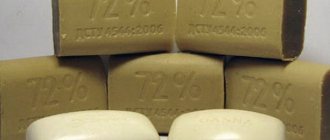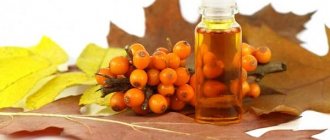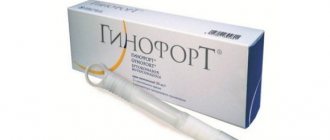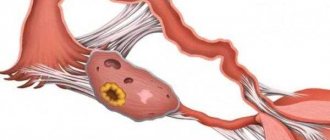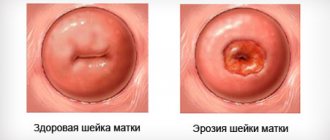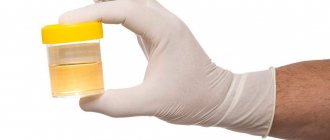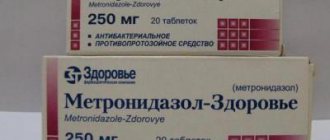Thrush (candidiasis) - a pathology caused by yeast fungi of the Candida family - are opportunistic. Activity can be provoked by many reasons: stress, neurosis, infectious diseases, long-term treatment with medications, etc. The disease is manifested by itching, burning and discomfort in the intimate area. Antibiotics for thrush are recommended in extreme cases when other drugs have not given the desired result. With the right approach, they can get rid of the problem in a matter of days.
List of antibiotics for thrush for women
Thrush (candidiasis) - a pathology caused by yeast fungi of the Candida family - are opportunistic. Activity can be provoked by many reasons: stress, neurosis, infectious diseases, long-term treatment with medications, etc. The disease is manifested by itching, burning and discomfort in the intimate area. Antibiotics for thrush are recommended in extreme cases when other drugs have not given the desired result. With the right approach, they can get rid of the problem in a matter of days.
Antibiotics: how to neutralize them?
Almost everyone knows how to properly deal with digestive disorders after a course of antibiotics - you need to drink preparations of the “right bacteria”, eat more fermented milk products, vegetables and fruits.
In the case of thrush, many do not know what to do and do nothing - that is, there is no prevention of the disease. Some women, succumbing to beautiful advertising, take a “magic disposable” capsule for thrush. and as a result, they get a lighter wallet, an additional load on the liver, exhausted by cold medications, and untreated thrush.
Therefore, it is very important to choose both an effective and gentle remedy for the prevention and treatment of thrush. Let's figure out what “effective” means and what “gentle” means.
An effective drug against thrush:
- actively suppresses the causative agents of the disease - fungi of the genus Candida albicans, preventing their growth and reproduction;
- quickly relieves unpleasant symptoms - itching, burning, discharge, etc.;
- acts directly at the site of inflammation.
Gentle drug:
- does not have an effect on the entire body, but “works” only locally, without “loading” the liver, kidneys and other body systems;
- does not suppress beneficial microorganisms of the mucous membrane, as a result of which the natural flora is preserved.
Levorin for thrush: description and instructions
Levorin is an antibacterial antifungal drug that has fungicidal properties. It has several forms of release - ointment in tubes, powder and tablets for internal use. The main active ingredient is levorin sodium salt. The active component is characterized by a pronounced antifungal effect. Today, this antibiotic is one of the best on the pharmaceutical market. It affects the membranes of pathogenic microorganisms, leading to increased susceptibility, and as a result, the fungi die.
The only contraindication is organic intolerance to the main substance or additional components. It is not recommended to prescribe the drug in infancy.
Directions for use against thrush:
- For vaginal candidiasis, the daily dosage is 400-500 thousand units twice a day, the duration of the therapeutic course is at least one and a half weeks;
- For thrush in children, a medicine is taken in the oral cavity at the rate of 25 thousand units per kilogram of body weight;
- If ointment is used, apply a thin layer to the affected area twice a day. Use time ranges from 8 to 12 days.
Important: while using Levorin, it is strictly forbidden to drink alcoholic beverages.
In accordance with the annotation of the product, the development of side effects cannot be excluded:
- Allergic manifestations - itching, burning, urticaria. In case of severe intolerance, Quincke's edema.
- Digestive system upset, vomiting, diarrhea, abdominal pain, increased gas formation.
- Dizziness – from the central nervous system.
- Increased temperature, weakness and apathy.
The drug is not prescribed in the first trimester. In the second and third - only on the recommendation of the attending physician. Do not use during breastfeeding, as the active components penetrate into milk.
Prevention
It has always been known that the best medicine is prevention. This is a very important point that allows you to prevent the development of the disease even after taking antibiotics. If you follow simple rules in a timely manner, you can avoid the development of symptoms of thrush after taking antibiotic drugs. To do this, carry out the following procedures:
- Initially, you need to pay special attention to self-care. This item includes taking a shower every evening and morning if necessary. It is important to change pads more often during menstrual periods, as well as change your underwear daily.
- Eat properly. To do this, you need to study the features of the diet, which will strengthen the immune system and improve well-being.
- During sexual activity, use condoms, which help prevent many different sexually transmitted diseases. This point is especially relevant if sexual adventures occur with different partners.
- Treatment of gynecological ailments that can occur at any age.
- To avoid the development of disease complications, it is necessary to visit the gynecological office as often as possible (once every 3–6 months).
- Give up bad habits: smoking, alcohol addiction and drug use.
Therefore, the conclusion can be drawn as follows: the health of each person does not depend on the attending physician, but on proper care of oneself and one’s health.
Amoxicillin against candidiasis: features of the drug use
The prescription of Amoxicillin is always individual, since the drug is not suitable for all patients. It all depends on the stage of development of candidiasis, gender and age group of the person. The drug is characterized by a wide spectrum of effects.
The tablets belong to the group of penicillins and are aimed at destroying harmful microorganisms. Against the background of infectious and inflammatory diseases that led to the development of thrush, the drug acts as monotherapy. In other cases, it is included in a comprehensive treatment regimen.
Taken orally. The drug is quickly absorbed in the gastrointestinal tract and is not destroyed in an acidic environment. The maximum concentration of active substances is observed two hours after application. The dosage is determined individually.
Standard doses according to instructions:
- For adult patients and children over 10 years of age, a single dosage is 250-500 mg.
- For advanced forms of thrush, it is recommended to take 1 g per day;
- For children aged 5-10 years, the dose is 250 mg; up to 5 years of age – 2.5 mg.
Please note that food intake does not affect the absorption of the drug, so it can be taken before, during or after meals.
Contraindications: allergic pathologies - bronchial asthma, allergy to penicillin, liver failure, dysbacteriosis, lactation. During pregnancy, medications are prescribed based on the principle of potential benefit and probable harm.
In girls, the medicine can cause a number of side effects:
- Allergic reactions in the form of hives, rashes.
- Nausea, vomiting, taste bud disturbance, diarrhea.
- Sleep disturbance, agitation, panic attack, depressive syndrome.
- Cramps, headaches and dizziness.
The combination of drugs for thrush for women and alcoholic beverages can provoke a severe allergic reaction, including death. In addition, this combination negatively affects liver functionality.
In most cases, the drug is well tolerated by patients. As for its effectiveness against thrush, the medicine does not help everyone.
Amoxiclav for the treatment of thrush
Amoxiclav is a modern medicine against candidiasis. It is highly effective against Candida fungi. The product has many side effects, so it is recommended as a last resort. It helps only in cases where the pathology is caused by inflammatory or infectious processes.
In fact, Amoxiclav is similar to the action of Amoxicillin, since it consists of it. However, clavulanic acid is present as an additional component. This combination leads to the destruction of fungi due to the binding of their surface receptors.
The dosage depends on the patient’s age, weight, severity of the infectious process in the body, condition of the liver and kidneys. The duration of the course of treatment ranges from 5 to 14 days, longer is not possible.
- Adults are prescribed 375 mg every 8 hours.
- 625 mg tablets every 12 hours.
Important: tablets differ in the ratio of active ingredients. It is prohibited to exchange 625 mg tablets (500 g amoxicillin + 125 g clavulanic acid) for 375 mg tablets (250 g amoxicillin + 125 g clavulanic acid).
An antibiotic rarely causes harmful effects. In most cases, negative phenomena are observed in people over 50 years of age. The most common complaints are nausea, general malaise, weakness and lethargy, and slight dizziness.
Terbizil for candidiasis: brief description and method of administration
Terbizil is an antibiotic intended for the treatment of damage to the skin, hair, nails and other parts of the body caused by fungi. It has a wide range of effects and effectively fights Candida fungus.
The active substances included in the drug block a special enzyme of pathogenic microorganisms, which is responsible for the production of biological molecules necessary for the formation of cells. This chain leads to subsequent destruction.
To treat thrush, medicine is prescribed in tablets. The ointment is practically not used in gynecological practice. Tablets are available in 125 and 250 mg. Absorbed within two hours, food intake does not affect.
Absolute contraindications for use:
- Organic intolerance.
- Pregnancy, lactation.
- Age up to 2 years.
- Liver dysfunction.
- Chronic kidney failure.
Adults are prescribed to take 250 mg once a day. For children under 12 years of age, the dosage is determined depending on body weight. The duration of the course is individual. For candidiasis, treatment lasts 7-10 days.
Nystatin
Nystatin is a systemic drug that fights fungus on the mucous membranes. Its components destroy the integrity of the cell membrane, which is why the microorganism stops growing and dies over time. The active substances act directly on fungi of the genus Candida, due to which the drug is highly active. The drug should not be taken if:
- weakened liver and kidneys (with partial dysfunction);
- pancreatitis and peptic ulcer;
- bearing and feeding a child.
Unlike previous drugs, the medicine is relatively well tolerated by the body and has no toxic effects. In some cases, nausea, stool changes, vomiting and local allergic reactions may occur.
You can take the tablets at any time - eating food does not affect the absorption of the drug in any way. The permissible dose is 250 thousand units (at one time) up to 8 times a day. If side effects are too severe, it is recommended to reduce the dose.
The average price for tablets is 38 rubles. There are no complete analogues, but if the tablets are poorly received, replace them with another dosage form: suppositories (93 r) or ointment (58 r).
Nystatin suppositories
Nystatin
Other antibiotics to get rid of thrush
Antibiotics for thrush in women are not varied. Conventional medications are not suitable for the treatment of an unpleasant disease; only those that, along with an antibacterial effect, have antifungal activity are needed.
The antibacterial treatment regimen should also include other drugs aimed at strengthening the immune system, helping to restore the full intestinal microflora. Vitamins, mineral complexes and immunomodulators are often prescribed.
Levomycetin for thrush, which has the main substance chloramphenicol, is never prescribed. On the contrary, the drug leads to candidiasis. This is due to the fact that its use washes away the beneficial intestinal microflora, leading to imbalance and dysbacteriosis, which appears to be a factor in the development of thrush.
List of antibiotics for thrush:
- Trichopolum is prescribed only in cases where candidiasis is the result of an infectious process in the body;
- Flemoxin is a mild and gentle antibiotic that can be used during pregnancy and lactation. Not effective for thrush caused by a fungus. But it helps against candidiasis caused by polyinfection;
- Metronidazole. The product is effective against only certain Candida fungi; helps get rid of thrush caused by infection. For fungi Candida tropicalis or Candida albicans – useless;
- Pimafucin is available in the form of tablets, cream and suppositories. The application option depends on the location of the thrush. It is a good drug that helps get rid of even the chronic form of candidiasis.
Self-medication of thrush leads to a chronic course of the disease, which is very difficult to cope with. Antibiotics are strong drugs and have many side effects, so only a doctor can prescribe them. The choice of drug to combat candidiasis is determined by the cause of its appearance, the type of Candida fungus, the age of the patient, and other factors that are taken into account when recommending an antibiotic.
The need to use antibacterial drugs
Antibiotics for thrush are used when thrush affects more than one organ, and the use of other medications does not show a positive result. Antimicrobial drugs are prescribed orally and locally. Injection treatment to eliminate only vaginal candidiasis is not carried out.
The main symptoms of vaginal candidiasis are burning, itching and curd-like discharge from the genital tract.
Antifungal agents do not show positive results in the treatment of candidiasis when thrush is complicated by an additional infection. This happens when the pathological process is prolonged. A decrease in the level of lactobacilli and the replacement of natural microflora with pathogenic ones is accompanied by a decline in immune defense. The infection can be caused by unprotected sexual contact, poor hygiene, and even the use of public bathing ponds.
For effective treatment, when selecting a medicine, it is necessary to undergo an analysis to determine the sensitivity of pathogenic microorganisms to the active components of the drug.
What antibiotics are effective for candidiasis
The main symptoms of thrush in women are vaginal discharge and itching, which does not disappear even after hygiene procedures. The disease can be diagnosed only after a gynecological examination and bacterial culture. Treatment of candidiasis is usually local. The doctor may prescribe antibiotics for candidiasis if conventional therapy is ineffective.
What antibiotics help with thrush
In the case of candidiasis, you should not self-medicate. Only the attending physician who knows the patient’s medical history can prescribe any medications, including antibiotics.
Levorin
Levorin helps cure candidiasis. The antibiotic is effective against yeast-like fungi Candida and Trichomonas vaginalis. The advantage of Levorin is the lack of accumulative properties, so it does not accumulate in the body. An antibiotic is prescribed for thrush of the gastrointestinal tract, mucous membrane and vagina, as well as for cutaneous candidiasis. Levorin can be taken to prevent candidiasis when carrying the fungus. In this case, the fungus does not cause symptoms of the disease, but there is a high risk of developing candidiasis.
The doctor prescribes the dosage of the drug individually in each case. It is very important to take into account the sensitivity of the microflora to the drug, the degree of development and localization of thrush.
Tablets and ointments are most often prescribed for candidiasis in men and adolescents. The course of treatment is usually 14 days.
- liver diseases;
- acute pathologies of the gastrointestinal tract;
- ulcerative lesions;
- uterine bleeding.
Levorin is prescribed with caution if there is a history of allergic reactions. When treated with an antibiotic, fever and cough may occur.
Sometimes levorine sodium acid is prescribed for thrush. This antibiotic comes in the form of a solution and is used for douching and rinsing. Rinsing with levorine sodium acid will help cure candidiasis in the oral cavity. The solution is added to distilled water during inhalation. To get results you need to perform 2-3 inhalations a day for 15-20 minutes.
Mycoheptin
For candidiasis, Mycoheptin may be prescribed. An ointment containing 1-15 g of antibiotic is suitable for the treatment of thrush. The drug is applied to the affected areas twice a day for two weeks. The ointment helps to quickly eliminate the symptoms of candidiasis from the head of the penis in men. Treatment of thrush with ointment cannot be combined with taking Mycoheptin tablets.
When treating candidiasis with Mycoheptin, kidney and gastrointestinal disorders may occur. If tests show increased levels of nitrogen in the blood or protein in the urine, you should stop taking the antibiotic. Usually these complications are accompanied by digestive disorders.
Contraindications:
- kidney and liver dysfunction;
- acute gastrointestinal diseases;
- individual intolerance.
In case of allergies, antihistamines are required. For nausea and abdominal pain, a solution of novocaine should be administered. If complications recur when treatment is resumed, Mycoheptin should be replaced.
Nystatin
Nystatin for candidiasis is prescribed in cases where the fungus affects the mucous membranes, organs and skin. Sometimes an antibiotic is prescribed to prevent disease during long-term treatment with tetracycline antibiotics. Nystatin is suitable for protecting an exhausted and weakened body.
The antibiotic is poorly absorbed and is therefore excreted from the body in feces. The success of treating candidiasis with Nystatin largely depends on the dosage.
Contraindications:
- hypersensitivity to components;
- ulcer of the stomach and duodenum.
The drug is low-toxic and therefore has a small number of side effects. Patients usually tolerate treatment well; in some cases, nausea, vomiting, diarrhea, chills and fever may occur. If these symptoms occur, the dosage should be reduced.
Pimafucin
For candidiasis, the doctor may prescribe Pimafucin. This drug has an antifungal effect due to the content of natamycin, a polyene antibiotic. Pimafucin blocks sterols in the cell membrane of fungi, causing their destruction and death.
Directions for use and dosage will differ for men, women, and adolescents. It is also necessary to take into account the location of the lesion. Pimafucin is produced in the form of tablets, suppositories and a special cream.
When treating candidiasis with Pimafucin, nausea and diarrhea may occur at the very beginning of therapy. Usually, unpleasant symptoms disappear on their own after a few days. Local treatment with drugs containing natamycin may cause a burning sensation and mild tissue irritation.
A contraindication to Pimafucin is individual sensitivity to the components of the drug. Pregnancy is not a contraindication.
Terbizil
For candidiasis, Terbizil is also prescribed. The effectiveness of the drug in the fight against candida is due to the activity of terbinafine. Depending on the type of fungus, the product may have a fungicidal and fungistatic effect. Treatment with the drug is permissible in patients over 12 years of age. Terbizil is taken orally once a day. The course of treatment may take 14-30 days.
In rare cases, the drug causes an exacerbation of the infection. Eye irritation, skin reactions (itching, flaking, pigmentation disorders), and fever are also possible. The antibiotic is not prescribed to pregnant and breastfeeding women.
Dalatsin
Women with thrush are prescribed Dalatsin. The antibiotic is produced in the form of vaginal suppositories. The drug contains clindamycin (100 mg in each suppository). Intravaginal treatment of candidiasis with Dalacin creates resistance to the antibiotic. Suppositories absorb active substances into the vagina, that is, directly at the site of fungal development.
Systemic use of Dalacin may cause diarrhea and colitis. To insert suppositories, you can use a special applicator. Before each procedure, it must be thoroughly washed with soap.
Dalatsin suppositories are best inserted into the vagina at night. The course of treatment for candidiasis is three days. If side effects occur, you should consult a doctor and replace the drug with an analogue. The product may reduce the strength of condoms and reduce the effectiveness of contraceptives.
- hypersensitivity to components;
- colitis associated with antibiotic use.
Summarizing
Before using any medications, be sure to read their instructions. If adverse symptoms occur after use, you should immediately consult a doctor. After treatment, you should definitely insist that your regular sexual partner also undergo treatment.
Very often, repeated relapses of candidiasis occur due to infection from a sexual partner. Treatment of thrush is useless if your sexual partner is a carrier of the disease. Only with an integrated approach to solving the problem can you forever forget about a disease such as candidiasis or thrush.
Comprehensive treatment of candidiasis
Complex therapy for candidiasis should be prescribed by a doctor. If symptoms of candidiasis occur in both partners, pair treatment should be carried out. If the disease is eliminated in only one partner, secondary infection with fungi will occur during sexual intercourse. Often women cannot get rid of thrush because their partners suffer from latent candidiasis.
Fluconazole
This antifungal drug is prescribed to men, women and children over 6 years of age. The active substance is fluconazole. Take one tablet (150 mg) once.
Contraindications:
- increased sensitivity;
- combination with Terfenadine and Cisapride;
- pregnancy and breastfeeding.
Side effects include headaches, diarrhea, nausea, rash, itching, and dizziness. In case of overdose, urgent gastric lavage is required. Fluconazole is not combined with anticoagulants, Benzodiazepine, Cisapride, Phenytoin, Tacrolimus.
Intraconazole (Mikotrox)
An antifungal drug is prescribed for the treatment of infectious lesions of the skin, mucous membranes and nails. The active substance is intraconazole. This is a synthetic compound from the triazole group.
The duration of treatment depends on the dosage. Express therapy can be carried out: 200 mg twice a day. For three-day treatment of candidiasis, you need to take 200 mg once a day.
Contraindications:
- pregnancy and breastfeeding;
- hypersensitivity to components;
- therapy with Midazolam, Nisoldipine, Triazolam and Eletriptan;
- chronic heart failure;
- fructose intolerance;
- lack of sucrose;
- age up to 3 years.
During therapy with Intraconazole, dizziness, nausea, diarrhea, and allergic reactions may occur. Patients with HIV and a history of transplantation require individual dose adjustment.
The effectiveness of the drug decreases when combined with Rifampicin, Rifabutin, Phenytoin. Some women experience disruptions in the menstrual cycle, and men experience reduced potency.
Ketoconazole
An antifungal drug based on ketoconazole. Prescribed for fungal infections of the skin, oral cavity, vaginal candidiasis and systemic fungal infections. The drug allows you to cure the disease in 5 days. You need to drink 200 mg twice a day. During treatment, abdominal pain, nausea, diarrhea, and headaches may occur.
Contraindications:
- hypersensitivity;
- impaired liver and kidney function;
- lactation;
- age up to 12 years.
Ketoconazole should not be combined with drugs that reduce stomach acidity. The drug is prescribed with caution to patients over 50 years of age, as well as to people with liver disease and allergies. Ketoconazole may increase the concentration of Ritonavir, Cyclosporine, Methylprednisolone and anticoagulants. Terfenadine and Busulfan may increase side effects. Ketoconazole is not prescribed in combination with Astemizole.
Restoring microflora
Restoring natural microflora is a simple process. To cope with the task at home, just follow the recommendations of experts:
- Maintain intimate hygiene by using products without chemical additives and with a neutral pH for washing.
- Change your underwear at least 2 times a day.
- Refuse synthetic panties in favor of products made from cotton fabrics.
- Adjust your lifestyle: get plenty of rest, walk more in the fresh air, avoid sedentary activity, balance your diet (focus on fermented milk products, fresh fruits and vegetables, lean varieties of fish and meat).
- Take vitamin and mineral complexes.
The restoration of microflora in gynecology after antibiotics can be accelerated with the help of pharmaceutical products: Bifiform, Linnex, etc. They activate the growth of beneficial bacteria, paralyzing the vital activity of rampant pathogens.
When women are diagnosed with thrush that has developed from antibiotics, the first thing they ask is whether it is possible to treat the fungus at home and how to speed up recovery. This disease can be treated on an outpatient basis, that is, without the help of medical personnel. The main thing is to understand the order and dosage of taking the prescribed medications.
Antibiotics for candidiasis in men
Treatment of conditions caused by fungi in men is carried out with the help of Pimafucin, Triderm, Flukost, Medoflucon. Typically, men require an increased dosage of medications.
Triderm
A drug based on the corticosteroid betamethasone and the antibiotic gentamicin. Has anti-inflammatory and antimycotic effects.
Contraindications:
- increased sensitivity;
- pregnancy;
- lactation;
- lupus;
- syphilis;
- skin ulcers;
- acne;
- psoriasis;
- phlebeurysm.
The drug reduces the effectiveness of latex contraceptives. Continuous treatment with Triderm for 14-20 days is not recommended. The cream is applied to the affected areas twice a day. At the first stage of treatment, some side effects may be observed: skin irritation, itching, dryness.
Flucostat
Antifungal agent based on fluconazole. For candidiasis, 400 mg is prescribed on the first day of treatment, then 200-400 mg. Oral candidiasis is treated with 50 mg per day for 14 days. For mucosal candidiasis, 50-100 mg per day is prescribed for 14-20 days. Treatment of vaginal candidiasis is carried out by a single dose of 150 mg of the drug. Prevention of fungal diseases: 150 mg once a month for a year. Children with candidiasis are prescribed 6 mg per kg on the first day, and then 3 mg per kg.
Contraindications:
- hypersensitivity;
- pregnancy;
- combination with Cisapride, Terfenadine and Astemizole.
When treating candidiasis with Flucostat, nausea, diarrhea, headaches, and rash may occur. In case of overdose, gastric lavage is required.
Medoflucon
An antifungal agent, the effectiveness of which is due to the presence of fluconazole in the composition. Medoflucon is prescribed when local therapy for acute vaginal candidiasis is ineffective.
Contraindications:
- hypersensitivity;
- taking Terfenadine, Cisapride, Astemizole, Pimozide, Quinidine, Erythromycin, Amiodarone.
Medoflucon is combined with caution with Halofantrine, Rifampicin, Hydrochlorothiazide, Alfentanil, Amphotericin, and anticoagulants. The drug can be taken in the first trimester of pregnancy.
For the treatment of candidiasis, adults are prescribed 150 mg once. For adolescents 12-17 years old, the usual dose of Medoflucon is prescribed in case of urgent need. In case of overdose, gastric lavage is urgently necessary.
- headache;
- nausea;
- diarrhea;
- rash;
- changes in blood composition;
- anemia;
- decreased appetite;
- insomnia;
- flatulence.
In combination with antibiotics, it is allowed to use local preparations (gels, ointments and creams). These are Clotrimazole, Batrafen, Anmarin, Dermazol, Candide, Zalain.
When treating candidiasis, antibiotics are prescribed only if topical medications are ineffective. In this case, there is a high probability that the disease is caused by an infection or combined with another pathology.
Any antibiotics should be prescribed only by a doctor, taking into account the results of the examination, the characteristics of the course of candidiasis and concomitant diseases. It is very important to rely on test results when prescribing treatment, since candida activity is similar to the symptoms of dangerous sexually transmitted diseases.
Which brand of thrush remedy to choose?
There is a huge selection of antifungal drugs for candidiasis. To purchase a high-quality and effective medicine, pay attention to the manufacturer before purchasing.
We have prepared a rating of the best companies that produce popular and safe products for the treatment of thrush:
2. Laboratoire Innotech International
Medicines from these pharmaceutical companies have excellent therapeutic properties. Often, one dose is enough to get rid of discomfort, but it should be remembered that the wrong dosage and duration of use can only eliminate external symptoms and not cure the disease, and this, in turn, causes a relapse. Therefore, you should not self-medicate; it is better to first discuss all the nuances of taking the medication with your doctor.
Diet
How to defeat thrush? The first thing you need to do is follow a diet. The basis of the diet should be fermented milk products, which contain a large supply of beneficial bacteria. Moreover, it is necessary to use natural products, and not products from stores.
It is also important to eat:
- fresh vegetables and fruits;
- legume products;
- natural juices, compotes and fresh juices.
In addition, it is necessary to maintain hygiene, lead a healthy lifestyle, get more rest and perform douching procedures with soda or other solutions. Diet is the basis of health, so if you decide not to easily cure a disease, but to really get healthier, then you need to start with proper nutrition.
- Traditional medicine recommends treating thrush with garlic. Moreover, you can use it not only orally, but also apply it to the vagina. But before placing it in the vagina, you need to wrap it in a bandage or gauze. It is necessary to place garlic in the vagina for 5–8 hours and preferably during sleep or rest. By repeating these procedures for 2-3 days, you can completely get rid of the disease.
- Wearing things made from natural materials. Tight and synthetic clothing should be avoided. Fungal spores contribute to the development of thrush from antibiotics if a woman wears underwear that does not allow the genitals and skin to “breathe.”
- Compliance with basic hygiene requirements. In addition to brushing your teeth, you should also monitor your perineal hygiene. To speed up the recovery process, you need to use toilet paper correctly. Otherwise, bacteria may enter the vagina.
The best suppositories for thrush
Livarol
The drug is an inexpensive and quite effective remedy for the first treatment of thrush. Not suitable for patients with a chronic form of the disease, because with prolonged or frequent use, the pathogen becomes resistant to the drug. The active substance, ketocosanol, disrupts metabolic processes in the cells of dermatophytes, yeast fungi, staphylococci, streptococci and causes their death. Recommended for use in the initial stages of the disease. There are 5 or 10 suppositories in a package.
Advantages:
- the active component is evenly distributed throughout the vaginal mucosa and restores its microflora;
- effectively eliminates the symptoms of acute vaginal candidiasis;
- suitable for the prevention of chronic thrush;
- has a combined effect: antifungal and antibacterial (although it is not an antibiotic).
The best tablets for thrush
Nizoral
The drug was created for systemic and local treatment of fungal diseases caused by a wide range of pathogens. The active ingredient, ketoconazole, has pronounced antifungal and mycostatic effects. It slows down synthesis, changes the composition of the cell membrane of fungi, which leads to the death of pathogenic microorganisms. With the bloodstream, the medicine spreads throughout the body, covering all locations of the fungal infection, so you can take tablets for various localizations of candidiasis. The duration of use should not be less than 5 days, even if the symptoms disappeared earlier. Otherwise, thrush pathogens will develop resistance to the drug.
Advantages:
- not absorbed into the general bloodstream;
- effective against fungal infections of various locations;
- allows you to effectively cope with candidiasis of varying severity;
- normalizes vaginal microflora.
Flaws:
- contraindications: severe kidney disease, liver disease, pregnancy, lactation, allergy to medication components;
- possible side effects: central nervous system disorders, gastrointestinal disorders, blood clotting.
Fluconazole
This powerful drug has many positive reviews. The active component, fluconazole, inhibits fungal enzymes, which provide the causative agent of candidiasis with complete nutrition, which promotes its reproduction and growth. Unlike other drugs with long-term treatment, Fluconazole is able to relieve mild forms of candidiasis in one dose (150 mg of medication). If the disease is recurrent, severe, or occurred while taking antibiotics, then the dosage and duration of treatment should be prescribed by a doctor, having previously assessed the patient’s condition.
Advantages:
- quickly absorbed;
- long lasting effect;
- actively fights the causative agent of thrush;
- quickly restores healthy microflora of the mucous membrane;
- prevents the growth and spread of pathogenic microorganisms;
- reduces signs of candidiasis after one application.
Flaws:
- possible adverse reactions: allergies, disruption of the central nervous system, kidneys, gastrointestinal tract, liver;
- contraindication: pregnancy;
- an overdose can cause paranoid behavior and hallucinations, so the treatment regimen should be prescribed exclusively by a doctor.
Dalatsin
Available in the form of cream or vaginal suppositories. Prescribed for bacterial thrush. The main active ingredient is clindamycin. The substance acts locally on pathogens and is practically not absorbed into the bloodstream.
The product is not recommended for use when:
- antibiotic-associated colitis (including a history);
- under age;
- with increased sensitivity to active and auxiliary components.
Take 1 suppository per day for 3 days. Local reactions in the form of slight irritation and itching are possible.
The average cost of Dalatsin is 638 rubles. Depending on the dosage form (suppositories or cream), the price may vary slightly. Analogs: Clindacin (281 rubles), Zerkalin (352 rubles), Klindovit (378 rubles).
Clindaline
Zerkalin
Klindovit
What remedy for thrush should I buy?
1. For the primary treatment of thrush, Livarol with antifungal and antibacterial effects is excellent.
2. A drug that is effective in the acute and chronic stages of thrush - Clotrimazole.
3. During pregnancy or lactation, Pimafucin is suitable.
4. Nystatin has the lowest cost. But it should be remembered that the drug is effective only with mushrooms, it has no effect on bacteria.
5. If you need a medicine that will be effective not only with thrush, but also with other infectious and inflammatory diseases of the genital organs, then it is better to choose Polygynax.
6. Remedies that will quickly eliminate thrush of any severity - Terzhinan, Nizoral.
7. If you need a medicine that quickly and effectively destroys pathogenic fungal microorganisms of any location, then it is better to choose the powerful domestic drug Fluconazole.
Analogs
The modern pharmaceutical market offers other medications containing fluconazole. The most popular brand product is the American Diflucan, which stands out among others due to its pronounced effect and high cost. Other well-known analogues of Fluconazole, which are sold in our pharmacies:
- Diflazon (KRKA, Slovenia);
- Mikomax (Zentiva k.s., Czech Republic);
- Mikosist (Gedeon Richter, Hungary);
- Fluconazole-Teva (Teva, Israel);
- Flucostat (Pharmstandard, Russia).



